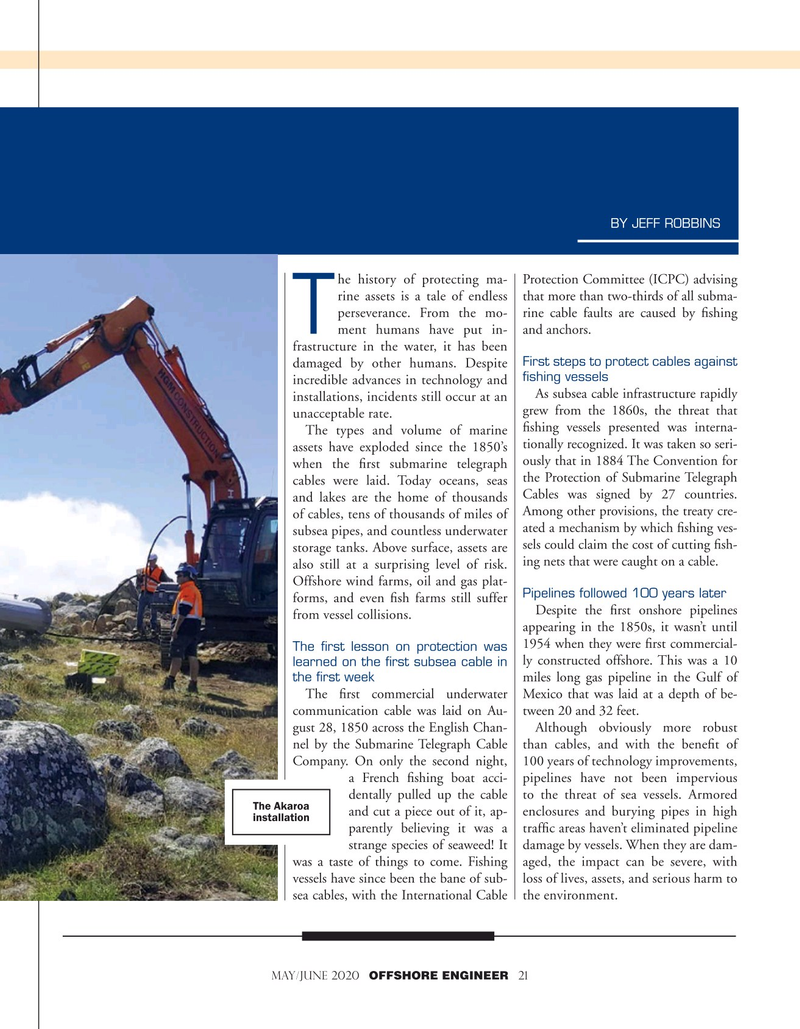
Page 21: of Offshore Engineer Magazine (May/Jun 2020)
Read this page in Pdf, Flash or Html5 edition of May/Jun 2020 Offshore Engineer Magazine
BY JEFF ROBBINS he history of protecting ma- Protection Committee (ICPC) advising rine assets is a tale of endless that more than two-thirds of all subma- perseverance. From the mo- rine cable faults are caused by fshing
T ment humans have put in- and anchors. frastructure in the water, it has been
First steps to protect cables against damaged by other humans. Despite fishing vessels incredible advances in technology and
As subsea cable infrastructure rapidly installations, incidents still occur at an grew from the 1860s, the threat that unacceptable rate.
The types and volume of marine fshing vessels presented was interna- assets have exploded since the 1850’s tionally recognized. It was taken so seri- when the frst submarine telegraph ously that in 1884 The Convention for cables were laid. Today oceans, seas the Protection of Submarine Telegraph and lakes are the home of thousands Cables was signed by 27 countries. of cables, tens of thousands of miles of Among other provisions, the treaty cre- subsea pipes, and countless underwater ated a mechanism by which fshing ves- storage tanks. Above surface, assets are sels could claim the cost of cutting fsh- also still at a surprising level of risk. ing nets that were caught on a cable.
Offshore wind farms, oil and gas plat-
Pipelines followed 100 years later forms, and even fsh farms still suffer
Despite the frst onshore pipelines from vessel collisions.
appearing in the 1850s, it wasn’t until 1954 when they were frst commercial-
The first lesson on protection was ly constructed offshore. This was a 10 learned on the first subsea cable in miles long gas pipeline in the Gulf of the first week
The frst commercial underwater Mexico that was laid at a depth of be- communication cable was laid on Au- tween 20 and 32 feet. gust 28, 1850 across the English Chan- Although obviously more robust nel by the Submarine Telegraph Cable than cables, and with the beneft of
Company. On only the second night, 100 years of technology improvements, a French fshing boat acci- pipelines have not been impervious dentally pulled up the cable to the threat of sea vessels. Armored
The Akaroa and cut a piece out of it, ap- enclosures and burying pipes in high installation parently believing it was a traffc areas haven’t eliminated pipeline strange species of seaweed! It damage by vessels. When they are dam- was a taste of things to come. Fishing aged, the impact can be severe, with vessels have since been the bane of sub- loss of lives, assets, and serious harm to sea cables, with the International Cable the environment.
MAY/JUNE 2020 OFFSHORE ENGINEER 21

 20
20

 22
22